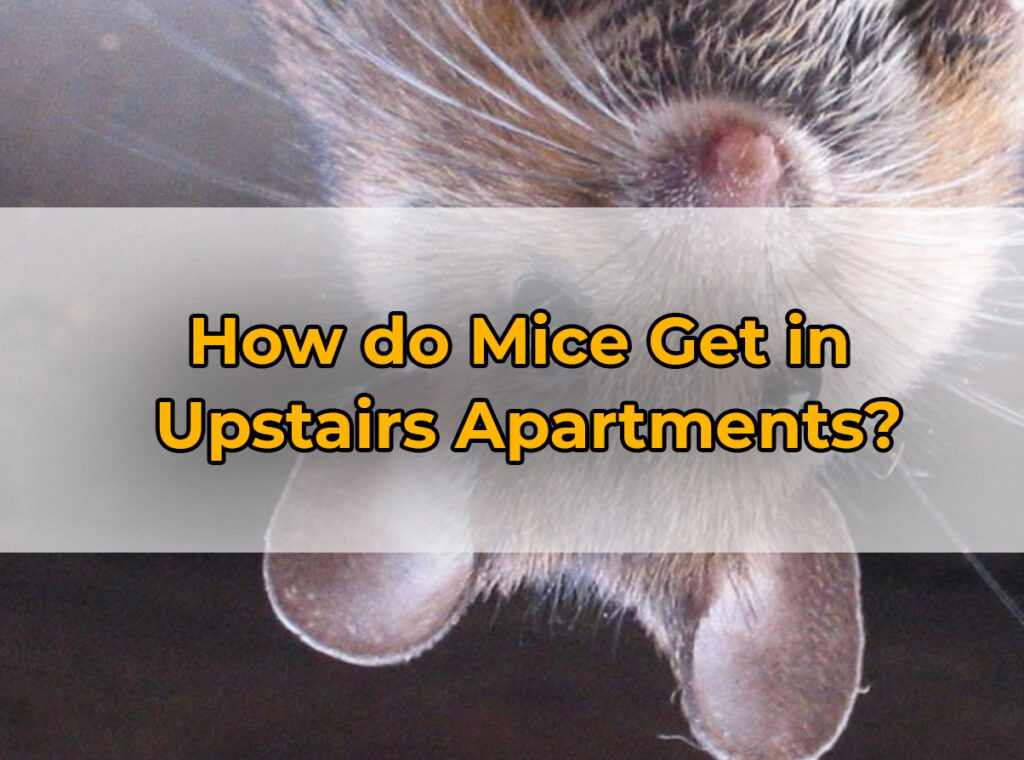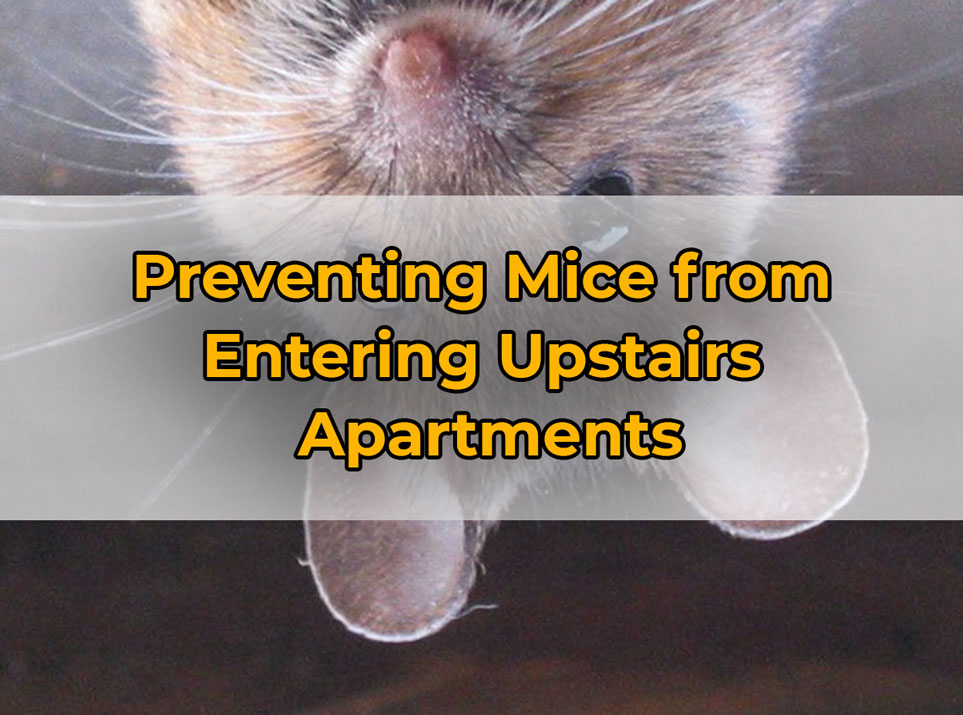Wondering how do mice get in upstairs apartments? Mice can be a nuisance in upstairs apartments, but understanding how they get in can help prevent them.
Their tiny bodies allow them to squeeze through gaps as small as a dime! With an average life of one year, they are determined to find food and make nests.
Preventive measures like sealing entry points and keeping a clean environment are important. However, mice can get in through cracks around windows or doors, unsealed utilities, or damaged siding. They can also travel through pipes and conduits between units.
Here we will discuss on how do mice get in upstairs apartments, why and how to troubleshoot!
Understanding the Behavior of Mice

Mice are clever creatures. They can enter even the most unexpected places, including upstairs apartments. It’s important to understand their behavior to stop infestations and deal with them.
These small intruders can fit through openings as small as a quarter inch. They can use gaps around windows, doors, pipes, and vents to get inside. Their flexible bodies help them move through tight spaces. It’s hard to keep them out.
They have a good sense of smell to find food from far away. They can climb walls to access upper floors, too.
Why Mice Get in Upstairs Apartments?

Mice may get into upstairs apartments for a variety of reasons, primarily driven by their need for food, water, and shelter. Here are some factors that contribute to mice entering upstairs apartments:
1. Food sources
One major factor is the abundance of food sources that attract mice. Mice are always on the lookout for a steady supply of food, and if you have any accessible edibles in your apartment or garbage disposal smells, it becomes an open invitation for them to venture into your space.
The first reason mice get into upstairs apartments is uncovered garbage bins. If you leave your trash cans outside without lids or fail to secure them properly, it’s an open buffet for mice. These rodents are scavengers by nature and can easily detect the smell of discarded food from afar.
Once they find a reliable food source like an overflowing or unsecured trash bin near your building, they will follow their noses right up to your upstairs apartment.
2. Water sources
One of the main reasons why mice are drawn to upstairs apartments is the presence of leaky pipes or faucets. Even minor leaks can create enough moisture for them to survive and thrive.
These small openings in plumbing systems may go unnoticed by residents until they start experiencing mouse infestations. Additionally, condensation on windowsills can occur due to temperature differences between the inside and outside of the apartment.
3. Warmth and shelter
Warmth and shelter are key factors driving mice to invade upstairs apartments. As temperatures drop, these small rodents instinctively seek refuge in cozy environments, making the upper floors of buildings an attractive target.
Mice can squeeze through tiny openings as small as a dime, allowing them easy access to the warmth and comfort provided by an upstairs apartment. Once inside, they find ample hiding spots in wall cavities, attics, or crawl spaces that offer both protection from predators and a favorable climate.
4. Building infrastructure
The design and construction of buildings play a significant role in determining how easily pests such as mice can access higher floors. Insufficient sealing of cracks and gaps during the building process allows these rodents to find their way into apartments, particularly on upper levels.
As mice are extremely nimble creatures with the ability to climb walls and jump significant heights, it becomes essential for proper preventive measures to be taken during construction.
Another factor contributing to mice infiltrating upstairs apartments is the presence of common entry points within the building’s infrastructure.
These opportunistic creatures can exploit various vulnerabilities such as utility lines, plumbing systems, and ventilation shafts that connect multiple floors together. Inadequate insulation or improperly sealed openings create pathways that allow mice easy access between different units throughout the building.
5. Shared spaces and neighboring infestations
Additionally, neighboring infestations can play a significant role in attracting mice to upstairs apartments. If a downstairs unit or nearby building has an existing mouse problem, these pests may seek refuge in higher floors where they perceive less risk or increased availability of resources. Check if there is mouse nest in couch on your apt.
6. Breeding and population growth
Mice are notorious for their rapid breeding capabilities, with a single female capable of producing up to 10 litters per year. This high reproductive rate, coupled with their ability to reach sexual maturity within weeks, leads to exponential population growth. As a result, mice colonies expand rapidly and seek out new territories when resources become scarce.
Upstairs apartments provide an ideal environment for mice as they offer protection from predators and easy access to food sources.
How do Mice Get in Upstairs Apartments?

Inspect the exterior of your upstairs apartment. Look for small cracks, gaps, or holes that mice can enter.
Check how do mice get in upstairs apartments before you prevent it!
1. Cracks and gaps
How do mice get in upstairs apartments? One of the answer lies in the cracks and gaps that exist within the building’s structure. These tiny openings provide the perfect entry points for these agile creatures.
Mice are incredibly nimble and can squeeze through openings as small as a dime. They are excellent climbers and can easily scale walls, allowing them to reach higher levels of a building with ease.
Once they locate a crack or gap, mice use their flexible bodies to wiggle through, finding themselves inside an upstairs apartment before you even realize it.
It is crucial for residents living on upper floors to be vigilant about sealing any cracks or gaps around windows, doors, and other areas where these pests could gain access.
2. Ventilation systems
These systems are designed to circulate air and maintain a comfortable living environment, but they can inadvertently become entry points for unwelcome visitors.
Mice are skilled climbers and can easily navigate their way through ductwork or vents that connect different floors of a building. With their flexible bodies and sharp claws, these small rodents can exploit even the tiniest gaps or cracks in the system.
The problem is compounded by the fact that many ventilation systems lack proper screening or barriers to prevent pests from entering. As a result, mice can use these pathways as convenient highways to explore higher floors and find shelter inside apartments.
Once inside, they can wreak havoc by gnawing on furniture, contaminating food supplies, and spreading diseases through droppings and urine. Check also: How To Get Rid of Ants in Bathroom.
3. Plumbing and utility lines
These tiny rodents possess an uncanny ability to exploit even the smallest openings, allowing them access to spaces that seem impenetrable. Understanding their entry points is crucial for preventing these unwanted guests from making themselves at home.
Mice are incredibly agile creatures, capable of squeezing through gaps as small as a pencil eraser. When it comes to accessing upstairs apartments, they take advantage of vulnerable areas such as pipe penetrations and utility line openings.
By climbing up vertical plumbing stacks or navigating through horizontal pipes, these resilient rodents can easily traverse between floors. Additionally, utility lines provide an enticing pathway for mice seeking shelter and sustenance from nearby homes or businesses.
4. Shared spaces
If there are shared spaces in the building, such as common hallways or stairwells, mice can enter through those areas and then make their way to upstairs apartments. They might find gaps around doors or other entry points along the way.
5. Carried in belongings
One common way mice enter upstairs units is by hitching a ride in belongings brought into the building. Whether it’s a moving box or a suitcase, these rodents can easily hide within the crevices and corners, waiting for an opportunity to scurry out and explore their new surroundings.
Preventing Mice from Entering Upstairs Apartments

After knowing how do mice get in upstairs apartments, here’s how to keep them away:
- Close off any openings – Mice can squeeze through small cracks, so fill them with caulk or steel wool.
- Keep a clean kitchen – Regularly clean up and get rid of food waste. Don’t leave pet food out overnight.
- Store food in airtight containers – This keeps mice from getting to it and also prevents them from being attracted.
- Minimize clutter – Rodents like to nest in piles of papers or items, so keep closets tidy and reduce hiding spots.
- Install door sweeps – Place these at the bottom of exterior doors to prevent mice from entering.
- Check vertical entry points – Mice can climb, so make sure windows are sealed and check for openings near utility lines or vents.
It’s important to remember that mice can enter upstairs apartments in other ways. They might travel through wall cavities or shared ventilation systems.
So, tenants in upstairs apartments need to communicate with their neighbors and landlord if they notice signs of a mouse infestation.
Dealing with an Existing Mouse Infestation
Dealing with an existing mouse infestation can be a daunting task, but with the right approach and knowledge, it can be effectively managed. But make sure you understand how do mice get in upstairs apartments!
- Start by spotting where mice might be entering your apartment – like cracks or holes in walls, doors, windows, and utility lines. Plug them up with caulk, steel wool, and other materials.
- Then, do a deep clean of your apartment. Focus on where mice may hide or nest, like attics, basements, and storage spaces. Remove any food sources that might entice them, and disinfect.
- Next, place traps strategically in areas where mice are usually seen. Pick the right kind of trap, or ask a pest control expert for advice.
- Regularly check and throw away any mice you capture to stop smells and more infestations.
- If you can’t get rid of the mice, call in a professional pest control service. They have the know-how and tools to handle even the toughest infestations.
- To stay mouse-free, keep your apartment clean, seal off entry points, store food in rodent-proof containers, and inspect your space often for signs of a new infestation.
- Take action against a mouse problem now so you don’t have to worry about health risks and having peace of mind in your home. Don’t wait – reclaim your apartment from these unwelcome guests!
Can mice get to a 3rd floor apartment?
Yes! Mice are incredible climbers and possess an amazing ability to squeeze through tiny openings. They can easily scale walls and navigate their way through pipes, ducts, and even elevator shafts. So yes, while it may not be as simple for them as scurrying across the ground floor, mice can indeed find their way into your third-floor abode if given the opportunity.
One important factor that allows mice to reach higher floors is accessibility. If there are any entry points or gaps in your building’s exterior – such as cracks in the foundation or poorly sealed windows – determined mice will find them.
Can mice go from one apartment to another?
The short answer is yes, mice have the capacity to travel between neighboring apartments. These small rodents possess a remarkable climbing ability and can effortlessly scale walls, pipes, and electrical wires. Their flexible bodies allow them to fit through openings as small as a dime or even smaller, making it relatively simple for them to navigate through shared walls or gaps in the building’s structure.
Will sleeping with the lights on keep mice away?
Simply keeping the lights on at night will not guarantee a mouse-free home.
Mice are nocturnal creatures, which means they are more active during the night when it is dark. Bright lights can disrupt their natural behavior and make them seek shelter in darker areas of your home, but it does not necessarily mean they will leave your house altogether.
Mice are resourceful animals that can adapt to various environments, including well-lit ones. They have excellent senses of smell and hearing, allowing them to navigate even in illuminated spaces.
Do mice go away on their own?
No! it will not go away on their own! Mice are highly adaptable creatures that can find food and shelter in even the smallest crevices of your home. If there is a steady source of food available, such as crumbs or unsealed pantry items, mice will have no reason to leave. Additionally, female mice can reproduce rapidly, with each litter consisting of up to 12 offspring. This means that if you have just one or two mice in your home, it won’t be long before their numbers multiply significantly.
What scares away mice?
One effective method is using peppermint oil, which has a strong scent that repels mice. By placing a few drops of peppermint oil on cotton balls and strategically placing them around your home, you can create an environment that mice find unpleasant and avoid altogether.
Another natural mouse deterrent is the presence of predators such as cats or even snakes. Mice have an instinctual fear of these creatures and will likely steer clear of areas where they detect their presence.
“There is no real ending. It’s just the place where you stop the story.”
